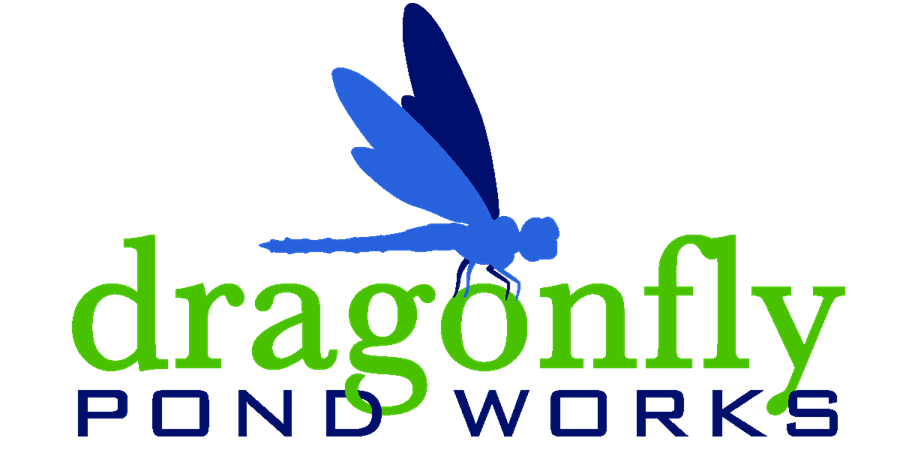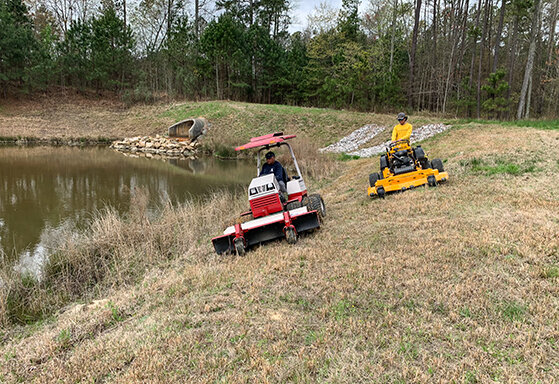Proper Mowing Practices for Stormwater Compliance & Safety
Are improper stormwater mowing practices putting you at risk for compliance violations and safety hazards?
Growing season is upon us, and now is a great time to review your mowing and maintenance programs to ensure your stormwater control measures (SCM’s) are both compliant and safe. Whether you have a wet pond, constructed wetland, or bioretention, all of these devices have specialized maintenance and mowing requirements. In this edition of Ask the Experts, we explain some of the specialized mowing needs of SCM’s, and highlight the importance of working with specialized stormwater vendors.
Should my pond vendor mow my SCM’s or can our landscaper do it?
This is a very commonly asked question. In our 15+ years of experience mowing and maintaining SCM’s, we find it works best to have a single vendor responsible for the entire inspected stormwater device. This includes not only the open water areas, but also the shoreline, side slopes, and dam.
Key Benefits of Utilizing a Stormwater Vendor:
Specialized slope mowers and brush cutting equipment mow and clear safely and efficiently
Crews are trained in best mowing practices for SCM’s
Knowledge of recommended mowing heights
Awareness and avoidance of plants that are part of the engineered pond design
It is common to see failed inspections due to over-mowing or “scalping” of turf. The teams at Dragonfly are trained in specialized stormwater mowing practices, including allowing the grass around your SCM’s to be slightly taller than what you’d expect to see in a typical common area. Remember that your SCM’s are engineered devices that require specialized maintenance to function properly in a compliant condition. We cannot stress this enough.
My board is complaining that the pond edge looks weedy and unmaintained. Why aren’t you mowing down to the water’s edge?
Most wet ponds and constructed wetlands have installed aquatic plantings as part of their design. The planting shelf, or littoral zone, should have a maintained but natural look. This is typically a 5-10’ wide zone along the shoreline. Littoral zone plants can be trimmed occasionally, but they should never be cut down completely or treated with herbicide. All too often, we are called after installed littoral plants are cut or sprayed by an inexperienced vendor. Hiring a specialized stormwater contractor to handle your mowing needs is the best way to avoid Annual Inspection hassles and costly replanting efforts.
My Board only thinks they need to mow their ponds once per year. Is this true?
Unfortunately, no. In the vast majority of cases, sites will need to be mowed multiple times during the growing season in order to be kept in a safe and compliant condition. For highly visible sites in residential communities, the recommended mowing frequency is approximately monthly through the growing season of March through October. For some commercial sites or sites where SCM’s are less visible, quarterly mowing can be sufficient to keep the area safe and accessible. Across our region, we are seeing increased municipal enforcement related to mowing so that SCM’s can be accessed safely for inspections and maintenance. A good stormwater contractor will have the specialized equipment to do the job safely, and will work with you to find the right mowing frequency to meet your needs and budget.
We acquired an old property and the ponds are heavily overgrown with trees and saplings. Can you help with this?
Absolutely. If you have recently acquired or taken on a new property with overgrown SCM’s or ponds that have not been maintained for several years, we can help. We own and operate multiple specialized brush clearing machines and slope mowers. Often times an initial tree and brush clearing is needed followed by seeding and regular mowing. This will allow grass to establish in place of saplings and woody vegetation. Grass is safer and less expensive to maintain.
Dragonfly Meets All of Your Stormwater Needs
Do not put your stormwater system at risk for failed inspections and safety hazards due to improper mowing practices. Our team of stormwater maintenance and turf management experts will work with you to create a customized plan focused on compliance and safety. Additionally, working with us provides access to a full-service stormwater maintenance company, with all in-house maintenance and repair capabilities. As the single source for all of your stormwater needs, we save you the inconvenience and headache of dealing with multiple or inexperienced vendors. All of our maintenance, mowing, and repairs services are documented for your records, and we provide detailed reports with photos after every Dragonfly service. Contact us today to keep your system healthy and safe.
Specialized Mowing, Stormwater Maintenance, & More
Has your pond failed inspection due to a lack of plants? Ask the Experts explains the role of plants, stormwater requirements, and some helpful tips on maximizing your investment.
Subscribe to our newsletter to receive informative and engaging news delivered right to your inbox.
Find us on Facebook, Twitter, Instagram, and LinkedIn for news, events, and more!
Dragonfly Pond Works provides specialized stormwater maintenance, aquatic plant management, stormwater compliance repair, and more in Raleigh, Durham, Charlotte, Wilmington, North Carolina, Myrtle Beach, Charleston, Columbia, South Carolina, Tampa, Sarasota, Naples, St. Petersburg, Fort Myers, Florida, and Atlanta, Athens, and Savannah, Georgia.




